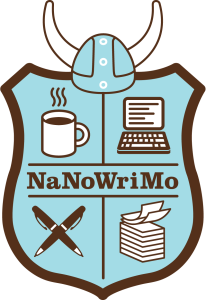by Bentley Clark
 Since writing the article “Are You Ready to Write a Novel in November?” regarding National Novel Writing Month (NaNoWriMo), much—or, as you will read, little—has happened.
Since writing the article “Are You Ready to Write a Novel in November?” regarding National Novel Writing Month (NaNoWriMo), much—or, as you will read, little—has happened.
In October, I was overcome with enthusiasm for writing fiction: the planning, the wordsmithing, the self-congratulating. I even read all of my back issues of Writer’s Digest. Oh, October was a gloriously productive month!
As November 1 approached and the 50,000 word goal loomed on the horizon, I bolstered my courage—as I do every year—with the mantra, “I’ve done it before, I can do it again. After all, I am a novelist.”
But I never crossed the 50,000 word finish line. So, what exactly happened? In an attempt to uncover what went wrong, I examined my writing process. Surely it is no different from a million other writers’ and, in many circumstances, these very steps yield New York Times Bestsellers:
Step 1: Prepare
I hit the ground running with this year’s NaNo novel. A compelling main character marched out of the detritus of my brain and demanded to have her story written. Alexandra was flawed and passionate and went about the business of murder with determination and devotion.
In preparation for telling Alexandra’s peculiar story, I devoured books about edible poisons. Mealtime conversations began and ended with me regaling my husband with the innumerable ways I could kill him with carefully concocted culinary delicacies. I cataloged the poisons, made color-coded notecards and pinned them to my bulletin board with care and shiny, silver pushpins. Then, I drafted the outline: the victims, the motives, and the murders.
With my cohesive outline and new-found expertise in killing a man with roots, flowers and berries, I was convinced this would be my best NaNo novel yet. After my meticulous preparation, my magnum opus of obsession and retribution would well-nigh write itself.
Step 2: Acquire the Proper Tools
No magnum opus is self-written without the proper tools. This particular book demanded a package of blue BIC Triumph 537R Rollerball pens, a new Moleskine notebook, Scrivener writing software and a dark, gothic Pandora station. (The book also requested Red Vines and chocolate-orange Piroulines, but I had to draw the line somewhere.)
Step 3: Brag About Your Derring-Do
If you are going to do something as ridiculous as writing a novel in a month, you might as well invite those around you to gawk. To that end, I told my husband and my parents that I was participating in NaNoWriMo again this year. But, in light of my brilliant, self-writing novel-to-be, I also took my braggadocio a few steps further by telling my boss and my work colleague. And then I wrote an article about it.
Making these sorts of announcements holds a writer’s feet to the fire: write a novel or eat crow.
Step 4: Brew Many, Many Pots of Tea and Stare Off into the Middle Distance
PG Tips tea is absolutely essential for this step. And a well-chosen writing soundtrack can prove indispensable for world-class, award-winning middle-distance staring. (See Step 2.)
Step 5: Sit Down and Write
While Steps 1-4 are optional, Step 5 is not.
On November 1, I sat down with my pens, my Moleskine, my Scrivener and my Pandora station and began to write. I managed to knock out the requisite 1,667 words a day for the first week or so. Then life came knocking on my home office door. Illness and family crises forced my novel into the back seat. And my enthusiasm went with it. Copious pots of tea were consumed and the middle distance was masterfully stared off into, but the story stalled at 17,000 words.
Alas, in 2015, I was many things. A novelist was not one of them. However, in my 17,000 words, I set the scene for two murders, wrote the backstory of two unfortunate but likable victims and discovered the tragic reasons for Alexandra’s murderous predilections. The magnum opus was neither magnum nor opus. But it was, ultimately, a start. A fantastic 17,000 word start. And there’s something to be said for that.
Step 6: Bake a Crow Pie
Know any good recipes?
 Bentley Clark hopes to one day make a career of drinking tea, staring into the middle distance, and using phrases such as “derring-do.”
Bentley Clark hopes to one day make a career of drinking tea, staring into the middle distance, and using phrases such as “derring-do.”
This article was originally published in the January 2012 issue of SouthWest Sage and is reprinted here by permission of the author.
Image “Out Of One’s Head, Relax The Brain” courtesy of thaikrit / FreeDigitalPhotos.net


